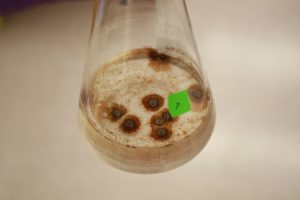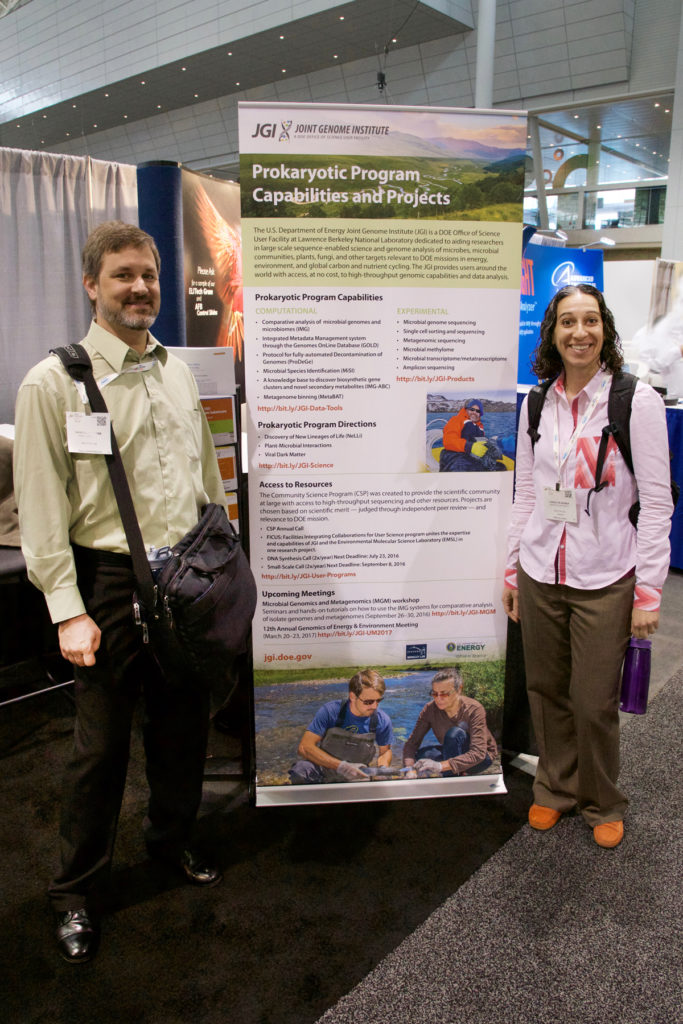Their unassuming appearances may cause them to be overshadowed by the plants or animals in their natural habitats, but fungi play key roles in maintaining their ecosystems. From breaking down leaf litter and decaying wood in forests to cleaning contaminated soils and waters, fungal enzymes are being characterized for potential use in a wide variety of energy and environmental challenges.

Pyrenochaeta sp. DS3sAY3a growing in liquid culture. As the fungus grows, brown-colored manganese oxides are formed. Here, the oxides can be seen associated with biomass and suspended in solution. (Carolyn Zeiner)
Fungal secretomes, those collections of all molecules secreted by a cell, contain enzymes that can break down plant cell wall components such as cellulose, hemicellulose and lignin. These capabilities make them of interest to bioenergy researchers looking for cost-effective ways to convert plant mass into sustainable, alternative transportation fuels. In a study published online July 19, 2016 in Plos ONE, a team led by researchers at Harvard University and Woods Hole Oceanographic Institution (WHOI) conducted a comparative analysis of the secretomes of four recently-isolated and sequenced filamentous Ascomycete fungi to learn more about the variety of pathways they deploy to break down carbon compounds.
“While the secretomes of model organisms such as the white-rot Basidiomycete Phanerochaete chrysosporium and members of the Aspergillus genus have been well characterized, little is known about the enzymatic capabilities of environmental isolates. Thus, the mechanisms of carbon degradation by many ubiquitous soil fungi remain poorly understood,” said study first author Carolyn Zeiner, now a postdoctoral research associate at Boston University. “This work suggests that a more taxonomically and mechanistically diverse community of fungal species contributes to environmental lignocellulose degradation beyond the traditional wood-rot Basidiomycetes.”
Fungal Research Made Possible Through FICUS Program
The research was made possible through a collaborative science initiative called Facilities Integrating Collaborations for User Science (FICUS) that offers researchers the capabilities of two DOE Office of Science User Facilities: the U.S. Department of Energy Joint Genome Institute (DOE JGI) at Lawrence Berkeley National Laboratory (Berkeley Lab), and the Environmental Molecular Science Laboratory (EMSL) at Pacific Northwest National Laboratory.
As described in the FICUS proposal filed by WHOI’s Colleen Hansel and University of Minnesota’s Cara Santelli, the team seeks to identify the carbon degradation pathways of filamentous Ascomycete fungi. One aspect of the project focuses on understanding the role of manganese (Mn) oxidizers in carbon degradation. The enzymes and Mn products produced by Mn oxidizing fungi rank among the strongest known oxidants on the planet, and play key roles in helping to break down even the most recalcitrant forms of lignocellulose.
For the study, the team studied four Mn(II)-oxidizing fungi known to play roles in cleaning up metal contaminated waters: Alternaria alternata SRC1lrK2f, Stagonospora sp. SRC1lsM3a, and Pyrenochaeta sp. DS3sAY3a were all isolated from coal mine drainage treatment systems in central Pennsylvania; Paraconiothyrium sporulosum AP3s5-JAC2a was isolated from a remediated freshwater lake in Massachusetts. All four fungi had had their genomes sequenced and annotated as part of the FICUS project to enable genomic and proteomic characterization of enzymes involved in manganese and carbon oxidation by these isolates.
Leveraging Tools at National User Facilities

Two of the Plos ONE study authors: co-author Sam Purvine (left), of PNNL, and first author Carolyn Zeiner (right), now at Boston University. (DOE JGI)
By comparing the composition and functional diversity of the secretomes with mass spectrometry at EMSL, the team was able to identify several lignocellulose-degrading enzymes for future study. “Our primary finding was that these fungi generate a wide variety of carbohydrate-active enzymes that can directly oxidize labile and recalcitrant carbon, in addition to a diverse suite of redox-active accessory enzymes that indirectly attack lignocellulose by forming reactive oxygen species,” said Zeiner. “The robust enzymatic machinery of these four Ascomycete species, combined with their known ability to degrade cellulose and to generate strong oxidants such as Mn(III) aqueous complexes and solid-phase Mn(III/IV) oxides, suggests a role for these species in lignocellulose conversion in the environment. This is particularly intriguing given that environmental lignin degradation is thought to be carried out primarily by Basidiomycete fungi.”
Zeiner noted that having access to the capabilities at the DOE JGI and EMSL “proved to be a powerful tool in exploring the molecular mechanisms of carbon degradation by soil microbes.” She elaborated on the resources the team utilized at these national user facilities. “Through collaboration with EMSL, we utilized state-of-the-art mass spectrometry facilities and leveraged expertise in quantitative, comparative proteomic methods—specifically, isobaric tags for relative and absolute quantitation (iTRAQ)—to identify over 1,300 secreted proteins per species. Additionally, we worked closely with EMSL bioinformaticists to develop a customized pipeline for protein data analysis and functional annotation that is now being successfully deployed on other EMSL proteomic projects. Through collaboration with JGI, we sequenced the genomes of our four Ascomycetes, resulting in a 400 percent increase in the number of protein matches that we were able to obtain compared to searching our datasets against the genomes of closely related species. This vastly improved our ability to harness our large datasets in drawing biological conclusions about the role of these species in carbon cycling. Finally, we collaborated with JGI bioinformaticists to generate genome-based predicted secretomes of the four species, which enhanced the functional annotation of our experimental data, aided in identifying intracellular proteins that were released into the secretome via lysis, and provided more robust assignments of carbohydrate-active enzymes (CAZymes).”
Colleen Hansel gave a brief overview of the early stages of her team’s research during a 2015 Google+ Hangout that outlined the FICUS initiative and the capabilities at the DOE JGI and EMSL. Watch it at http://bit.ly/JGI-EMSL030415Hangout.